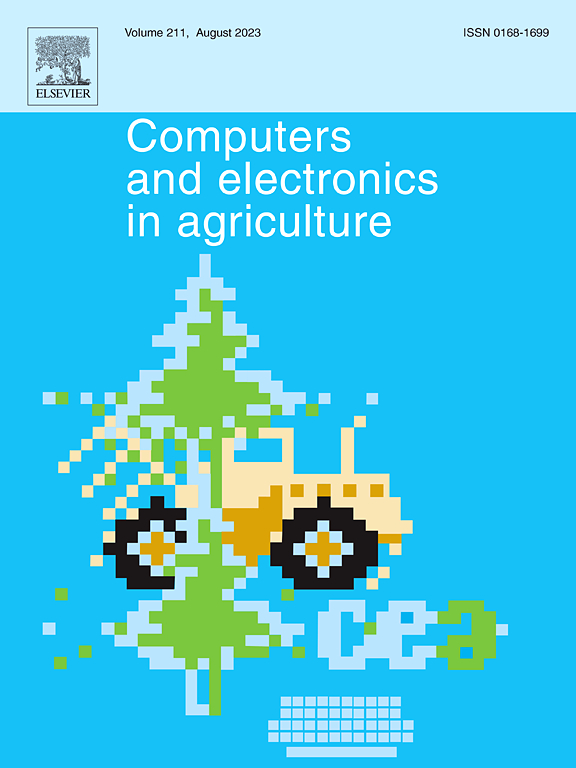基于时间序列遥感光谱特征重构的深度学习和迁移学习玉米种子分类
IF 8.9
1区 农林科学
Q1 AGRICULTURE, MULTIDISCIPLINARY
引用次数: 0
摘要
准确绘制玉米种子田的空间分布图对确保种子供应至关重要,但由于种间作物栽培的相似性,玉米种子分类仍然具有挑战性。本研究旨在建立一个更适合种子玉米的分类体系。提出了一种基于时间序列光谱重构的特征构建方法,通过将光谱反射率信息与时间约束同时反射到像素级灰度图像上,明确增强了时谱相关性。为了明确分类策略对玉米精细种间分类任务的好处,我们从时间成本和准确性两个角度比较了端到端直接分类和层次分类两种分类策略。结果表明,在整合农业知识获得的最佳时间序列范围(3 - 9月初)下,ResNet-101的平均准确率为91.34%,优于其他分类模型。输入特征重要性分析揭示了该模型在整个成长过程中的分类机制。为了提高模型的泛化能力,我们构建了两个迁移学习框架进行比较。当引入的目标域样本比例较小时,构建联合数据集训练模型的准确率提高较快;源域预训练-目标域微调方法在引入样本数量较大时准确率较高。本研究可为其他作物的种间分类问题提供参考。本文章由计算机程序翻译,如有差异,请以英文原文为准。
Classification of seed maize using deep learning and transfer learning based on times series spectral feature reconstruction of remote sensing
Accurately mapping the spatial distribution of seed maize fields is critical to securing seed supply, yet seed maize classification remains challenging due to similarities in interspecific crop cultivation. This study aims to construct a more suitable classification system for seed maize. A feature construction method based on time series spectral reconstruction was proposed, which explicitly enhanced the temporal-spectral correlation by reflecting the spectral reflectance information along with the temporal constraints onto the pixel-level grayscale image simultaneously. To clarify the benefits of classification strategies on the task of fine interspecific classification of maize, we compared two classification strategies, end-to-end direct classification and hierarchical classification, from the perspectives of both time cost and accuracy. The results showed that under the optimal time series range (March-early September) obtained by incorporating agricultural knowledge, ResNet-101 achieved an average accuracy of 91.34 %, which was better than other classification models. The input feature importance analysis revealed the classification mechanism of the model throughout the growth period. In order to improve the generalization ability of the model, we constructed two transfer learning frameworks for comparison. The accuracy of the method of constructing a joint dataset to train the model improved faster when the proportion of target domain samples introduced was small; the accuracy of the source domain pre-training-target domain fine-tuning method was higher when the number of samples introduced was larger. This study may provide a reference for the interspecific classification problem of other crops.
求助全文
通过发布文献求助,成功后即可免费获取论文全文。
去求助
来源期刊

Computers and Electronics in Agriculture
工程技术-计算机:跨学科应用
CiteScore
15.30
自引率
14.50%
发文量
800
审稿时长
62 days
期刊介绍:
Computers and Electronics in Agriculture provides international coverage of advancements in computer hardware, software, electronic instrumentation, and control systems applied to agricultural challenges. Encompassing agronomy, horticulture, forestry, aquaculture, and animal farming, the journal publishes original papers, reviews, and applications notes. It explores the use of computers and electronics in plant or animal agricultural production, covering topics like agricultural soils, water, pests, controlled environments, and waste. The scope extends to on-farm post-harvest operations and relevant technologies, including artificial intelligence, sensors, machine vision, robotics, networking, and simulation modeling. Its companion journal, Smart Agricultural Technology, continues the focus on smart applications in production agriculture.
 求助内容:
求助内容: 应助结果提醒方式:
应助结果提醒方式:


